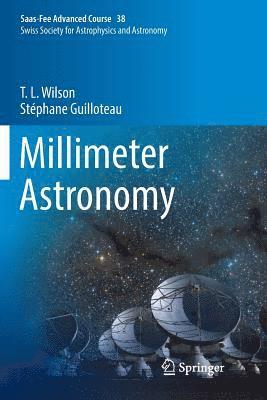
- Format
- Previously published in hardcover
- Språk
- Engelska
- Serie
- Saas-Fee Advanced Course (del 38)
- Antal sidor
- 183
- Utgivningsdatum
- 2019-02-01
- Förlag
- Springer-Verlag Berlin and Heidelberg GmbH & Co. KG
- Dimensioner
- 234 x 156 x 10 mm
- Vikt
- ISBN
- 9783662586020
- 277 g
Millimeter Astronomy
Saas-Fee Advanced Course 38. Swiss Society for Astrophysics and Astronomy
- Skickas från oss inom 7-10 vardagar.
- Fri frakt över 249 kr för privatkunder i Sverige.
Passar bra ihop
De som köpt den här boken har ofta också köpt Braiding Sweetgrass av Robin Wall Kimmerer (häftad).
Köp båda 2 för 1073 krKundrecensioner
Fler böcker av författarna
-
Viewer Indiscretion
T L Wilson
-
Molten Key
T L Wilson, T L Wilson, T L Wilson
-
Tools of Radio Astronomy - Problems and Solutions
T L Wilson, Susanne Hüttemeister, Susanne Huttemeister, T L Wilson
-
H II Regions and Related Topics
T L Wilson, D Downes
Övrig information
About the Authors: Thomas L. Wilson was on sta? at Max-Planck-Inst. f. Radioastronomie from 1969-2004. During this time, he was sent to Arizona as Director of the Sub-mm Telescope Observatory (1997-2002). After this, he was Project Scientist (2004-6), Associate Director (2006-8) and at European Southern Observatory, and subsequently Senior Scientist at ALMA (Atacama Large Mm/sub-mm Array), from Feb 2009 to March 2010. From April 2010 to December 2015, he was at the Naval Research Laboratory, then the NSF Division of Astronomical Sciences, working in the Spectrum Management Unit. Since December 2017 he has an emeritus position with the Max-Planck-Institute for Radioastronomie in Bonn. Stéphane Guilloteau is "Directeur de Recherche de classe exceptionnelle at CNRS" in Bordeaux. He graduated from the Ecole Normale Supérieure de Paris. He was recruited at CNRS in 1980, just after the creation of an Astrophysics Group at Université de Grenoble. In 1987, he became project scientist of the IRAM interferometer, and later, deputy director of IRAM. He worked on the conception and design of ALMA as Project Scientist between 1999 and 2003. He then joined the Université of Bordeaux. In 1989, he received the "Young Scientist" prize of the Société Française d'Astronomie et d'Astrophysique. ¿ About the Editors: Miroslava Dessauges-Zavadsky graduated in Physics from the University of Lausanne. She got her PhD in Astrophysics from the University of Geneva after having benefited from a two-years doctoral studentship at the European Southern Observatory in Munich. Then she came back to the Geneva Observatory as a post-doctoral fellow. Since 2010, she has there a permanent position as a scientific collaborator in the extragalactic group and as a local expert in millimeter wavelength observations. Daniel Pfenniger is Professor of Extra-Galactic Astrophysics at Geneva Observatory, the Astronomy Department of University of Geneva.¿ He studied Physics at University of Geneva, and Astronomy at Universities of Geneva and Hamburg.¿ He obtained a PhD in Galactic Dynamics at Geneva Observatory in 1985, and subsequently a post-doctoral grant for a stay at the Institute for Advanced Study, Princeton, USA.¿¿ His works bears on galactic dynamics in spiral and elliptical galaxies, cold hydrogen forms in the interstellar medium as dark matter component, and cosmological massive neutrinos.
Du kanske gillar
-
Nexus
Yuval Noah Harari
Häftad -
Orbital
Samantha Harvey
Häftad


